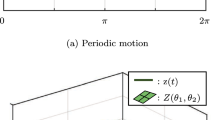Abstract
The nonlinear second-order difference equationx n+1=axn(1-xn−1), where 0≦x nX≦1 anda ≧1, is examined from varying points of view, analytical, numerical and geometrical. An analytic expression is obtained for an invariant attracting curveC ∞ (a) in phase space, which becomes the central object of study. This basic curve, which replaces the simple parabolic shape typical of many analogous first-order models, may have a complicated geometrical structure. As the parametera increases,C ∞(a) undergoes transformations characterized by the dynamical descriptions: stable node→stable focus→stable limit cycle →chaotic attractor. Although the limited characterization ofchaos by the appearance of nonperiodic solutions and solutions of arbitrarily large period is relied upon, this appears to be only a simplified approximation of the real behavior of solutions. Trajectories (x n, xn+1),n=0,1,…, are calculated using the related nonlinear planar mapT a(x,y)=(y,ay(1−x)), and regions of persistence and escape are described for characteristic values ofa. The study of persistence, of even more fundamental interest than the associated problems of periodicity and stability, receives special attention. We introduce a geometrical model, similar in many respects to that for the well-known analoguex n+1=axn(1−x n), but having several new and important features. It appears that as the parametera increases in the chaotic regime there are infinitely many intermittent bursts of increase in the probability that any initial point (x 0, x1) will persist in the unit square under successive iterations of the mappingT a, an unexpected property that should be of interest for applications. A discussion of the applicability of these results to population dynamics theory is given, and it is suggested that such equations might find useful application to problems in developmental biology as well.
Similar content being viewed by others
Literature
Clark, C. W. 1976.Mathematical Bioeconomics. New York: John Wiley.
Cunningham, W. J. 1954. “A Nonlinear Difference-Differential Equation of Growth.”Proc. Nat. Acad. Sci. U.S.A.,40, 708–713.
Guckenheimer, J., G. Oster and A. Ipaktchi. 1977. “The Dynamics of Density Dependent Population Models.”J. Math. Biol.,4, 101–147.
Hoppensteadt, F. C. and J. M. Hyman. 1977. “Periodic Solutions of a Logistic Difference Equation.”SIAM J. Appl. Math. 32, 73–81.
Hutchinson, G. E. 1948. “Concluding Remarks.”Cold Spring Harbor Symp. Quant. Biol.,22, 415–427.
Jones, G. S. 1962. “On the Nonlinear Differential Difference Equation,f′(x)=αf(x−1)[1+f(x)].”J. Math. Anal. Appl.,4, 440–469.
Kaplan, J. L. and J. A. Yorke. 1975. “On the Stability of Periodic Solution of a Differential-Delay Equation.”SIAM J. Math. Anal.,6, 268–282.
Kolata, G. B. 1978. “Computer Science: Surprisingly Fast Algorithms.”Science 202 (24), 857–858.
Landahl, H. D. 1979. Personal Communication.
Lasota, A. and D. Rusek. 1970. “Problems of the Stability of Motion in the Process of Rotary Drilling with Clogged Bits.”Archiam Gornictaa,15, 205–216.
—. and J. A. Yorke, 1973. “On the Existence of Invariant Measures for Piecewise Monotonic Transformations.”Trans. Am. Math. Soc.,186, 481–488.
Levine, S. H., F. M. Scudo and D. J. Plunkett. 1977. “Persistence and Convergence of Ecosystems: An Analysis of Some Second Order Difference Equations,”J. Math. Biol.,4, 171–182.
Li, T.-Y. and J. A. Yorke, 1975. “Period Three Implies Chaos.”Am. Math. Monthly,82, 985–992.
Lorenz, E. N. 1963. “Deterministic Nonperiodic Flows.”J. Atmos. Science,20, 130–141.
—. 1964. “The Problem of Deducing the Climate From the Governing Equations.”Tellus,16, 1–11.
Mandelbrot, B. B. 1977.Fractals—Form, Chance and Dimension. San Francisco: W. H. Freeman.
May, R. M. 1973.Stability and Complexity in Model Ecosystems. Princeton: The University Press.
—. 1974. “Biological Populations with Nonoverlapping Generations: Stable Points, Stable Cycles and Chaos.”Science,186, 645–647.
—. 1976. “Simple Mathematical Models with Complicated Dymanics.”Nature,261 (5560), 459–467.
—. and G. A. Oster. 1976. “Bifurcations and Dynamical Stability in Simple Ecological Models.”Am. Naturalist,110, 573–599.
Oster, G. and Y. Takahashi, 1974. “Models for Age Specific Interactions in a Periodic Environment.”Ecological Monographs,44, 483–501.
Ross, G. G. 1972. “A Difference-Differential Model in Population Dynamics,”J. Theor. Biol.,37, 477–492.
Royden, H. L. 1968.Real Analysis, Second Edition New York: MacMillan Publishing Co.
Ruelle, D. and F. Takens. 1971. “On the Measure of Turbulence.”Comm. Math. Phys.,20, 167–192.
Russell, Michael. 1978. Personal Communication.
Smale, S. 1965. “Diffeomorphisms with Many Periodic Points” inDifferential and Combinatorial Topology ed. by S. Cairns. Princeton: Princeton Univ. Press, 6380.
Smith, J. Maynard. 1971.Mathematical Ideas in Biology, Cambridge: The University Press.
Ulam, S. 1960.A Collection of Mathematical Problems. New York: Interscience.
Utida, Syunro. 1957. “Population Fluctuation, An Experimental and Theoretical Approach.”Cold Spring Harbor Symp. Quant. Biol.,22, 139–151.
Wright, S. 1938. “The Distribution of Gene Frequencies Under Irreversible Mutation.”Proc. Nat. Acad. Sci. U.S.A.,24, 253–259.
Author information
Authors and Affiliations
Rights and permissions
About this article
Cite this article
Pounder, J.R., Rogers, T.D. The geometry of chaos: Dynamics of a nonlinear second-order difference equation. Bltn Mathcal Biology 42, 551–597 (1980). https://doi.org/10.1007/BF02460970
Received:
Revised:
Issue Date:
DOI: https://doi.org/10.1007/BF02460970




